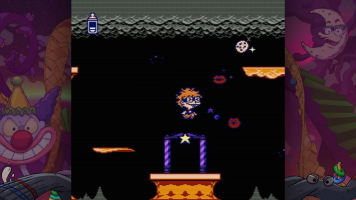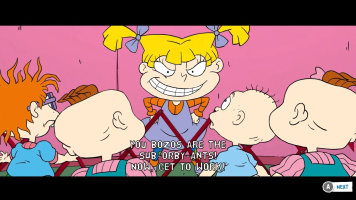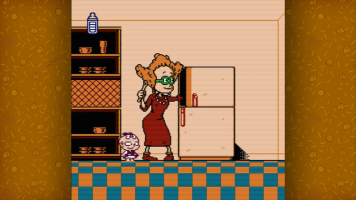Official Review
Rugrats: Adventures in Gameland's most essential victory, then, isn't necessarily its stage design or graphical style, but tapping into the show's intelligence. It's a shame the original voice cast is unavailable, with exchanges instead represented in text, but you can still recall Tommy's raspy tones in your head.
Much as it did in almost every episode of the show, the game's plot revolves around the imagination of the Rugrats gang spiraling wildly out of control. After seeing a TV spot for a new Reptar video game (Reptar being a fictitious dinosaur riff on Godzilla), the babies then turn their limited world into a video game of their own. Stages are set in areas around the household: attic, backyard, kitchen, sandbox, bedroom, and living room. Of course, the mundane morphs into something magical through an infant lens, the sandbox becoming a vast, pitfall-laden desert, the kitchen fridge a mechanical maze of cabling and electricity spikes, and the attic a fully-fledged house of horror. It's all thoughtfully designed, conceptually speaking, to capture the spirit of the show.
You have four playable Rugrats to choose from: Tommy Pickles, siblings Phil and Lil, and nerdy, flame-haired Chuckie. The parents make appearances about the house, maniacal Angelica is prominent during cutscenes, and those who know the show well will recognize the game's bosses.
The aim is to recover special Reptar coins scattered throughout each stage to unlock a door behind the living room TV, leading to the game's final area. You can take on the initial six stages in any order you like, and, during gameplay, can switch between any of the four Rugrats on the fly. All characters have a ground pound and enemies are typically dispatched by head jumps. The babies can also lift certain objects, like blocks, and use them to build climbable structures. Some enemies will take a daze from a normal head bop, and can then be picked up and thrown - a technique that comes to the fore during certain boss battles.
Stage layouts are built around exploration. Recovering Reptar coins is the main objective, but you will also need to find a screwdriver to unlock the boss door. Thankfully, it's well thought out and enjoyable to disassemble thanks to the Rugrats' different gameplay properties. Lil is able to briefly float in a Princess Peach manner, Chuckie has a Luigi long jump arc, Phil has a higher hop, and Tommy, our hero, responds more in the classic Mario vein. By getting to grips with the pros and cons of your infant team, you can switch them out by pausing the game, and this functions the same in both single-player and two-player co-op modes. Ideally, we would have liked a more fluid in-game character switch option rather than going to a pause screen, which feels cumbersome, but it's no dealbreaker.
While using different Rugrats for different degrees of air travel is fun, it doesn't get as deep as other games that use this same structuring. Those who enjoy platforming exploration with a decent level of challenge will have fun with this, though, and keeping your baby team in play by rationing health items definitely requires strategizing.
As Rugrats: Adventures in Gameland is based on a well-known cartoon, the aesthetic here actually matters quite a bit. Thankfully, the styling is totally precise, not missing a beat where the characters, colors, and even line work is concerned. We do tend to find Flash-style rendering — that ultra-clean, shadow puppet movement — unappealing, but it admittedly represents the show here very well. That said, a CRT filter wouldn't have gone amiss, just to capture some of that '90s Saturday morning TV fuzz.
What is genuinely impressive, however, is the ability to switch the game into 8-bit mode on the fly. Now, we aren't even sure why this was necessary, since the effort involved in depicting the game twice seems overkill - but boy, are we thankful they did. Switching the graphical mode reverts everything into an incredibly authentic NES game, complete with sprite limit flicker. It's so faithful, in fact, that Limited Run Games is releasing the 8-bit rendering on a physical NES cartridge for $60.
It's down to the player which graphical mode to stick with: a game that resembles the cartoon almost identically, and in widescreen, or that which conjures incredible nostalgia and works brilliantly as an 8-bit title. Personally, we think the 8-bit variant feels right, not just because it's a callback to the era in which Rugrats first aired, but because the assembly of the game seems to make more sense. The music, too, is excellent and available in both modern and chiptune variants, and you can mix and match the soundtracks over both visual options.
Conclusion
Rugrats: Adventures in Gameland is a well-made platformer that captures the heart of what made the TV show tick, and that's perhaps its greatest achievement. The character swapping system isn't unique, but it works well owing to some clever and occasionally quite challenging stage design; and, while it doesn't reinvent the wheel, there's a fun action game here with a good level of exploration. Whether you're drawn to the HD or retro aesthetic variants is down to which of your nostalgic sentiments is strongest. Either way, the 8-bit representation is so accurate to hardware of that era we can't believe it wasn't actually released three decades ago.




